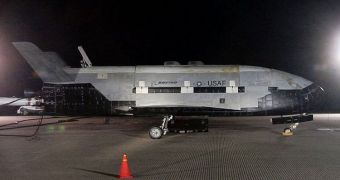Officials from the US Air Force (USAF) say they cannot divulge when the X-37B space plane will return to Earth. The robotic spacecraft – a smaller, unmanned version of the NASA space shuttles – has already spent more than seven months in low-Earth orbit (LEO).
The USAF is very secretive about its spacecraft, which was constructed by the Boeing Phantom Works division. The machine is capable of spending as much as 270 days in Earth's orbit, producing electricity from sunlight via built-in solar panels.
When development first began on this machine, the project belonged to NASA, which eventually transferred it to the Pentagon's US Defense Advanced Research Projects Agency (DARPA). Ultimately, the X-37B project was taken over by the Air Force.
The first space plane, called Orbital Test Vehicle 1 (OTV-1) successfully finished the series' maiden voyage on December 3, 2010, after launching to LEO on April 22. The spacecraft flew a total of 224 days, 9 hours, 24 minutes.
OTV-2 was launched on March 5, 2011, and has already exceeded 200 days in orbit. “On-orbit experimentation is continuing, though we cannot predict accurately when that will be complete,” USAF Lt. Col. Tom McIntyre said in a recent briefing,.
“We are learning new things about the vehicle every day, which makes the mission a very dynamic process,” he added. In a separate interview with Space, the official explained that the initial plan was to send OTV-2 on a 9-month mission.
If possible, he went on to say, the USAF will extend the current mission even further, stretching the spacecraft to its limits. This will “allow us to extract the maximum value out of the mission,” he said.
As the USAF is pondering its options on continuing to develop this new space technology, Boeing is already considering creating new derivatives from the machine. Modified versions of the space plane could be used to carry cargo and astronauts to the International Space Station (ISS).
The company is already developing the CST-100 manned space capsule, as part of the NASA Commercial Crew Development (CCDev) program. If successful in both endeavors, the corporation could gain the upper hand in the race to provide NASA with private orbital capabilities.

 14 DAY TRIAL //
14 DAY TRIAL //